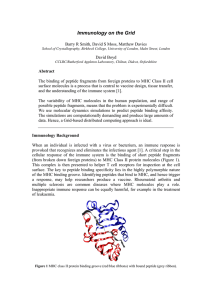Document 14262896
advertisement
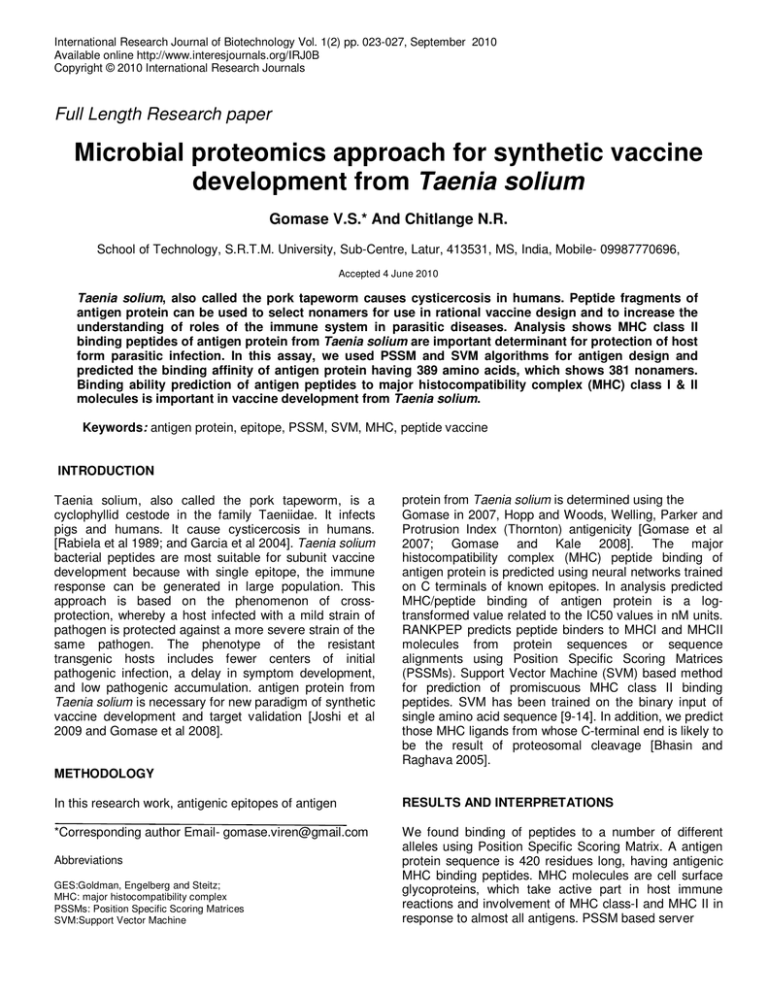
International Research Journal of Biotechnology Vol. 1(2) pp. 023-027, September 2010 Available online http://www.interesjournals.org/IRJ0B Copyright © 2010 International Research Journals Full Length Research paper Microbial proteomics approach for synthetic vaccine development from Taenia solium Gomase V.S.* And Chitlange N.R. School of Technology, S.R.T.M. University, Sub-Centre, Latur, 413531, MS, India, Mobile- 09987770696, Accepted 4 June 2010 Taenia solium, also called the pork tapeworm causes cysticercosis in humans. Peptide fragments of antigen protein can be used to select nonamers for use in rational vaccine design and to increase the understanding of roles of the immune system in parasitic diseases. Analysis shows MHC class II binding peptides of antigen protein from Taenia solium are important determinant for protection of host form parasitic infection. In this assay, we used PSSM and SVM algorithms for antigen design and predicted the binding affinity of antigen protein having 389 amino acids, which shows 381 nonamers. Binding ability prediction of antigen peptides to major histocompatibility complex (MHC) class I & II molecules is important in vaccine development from Taenia solium. Keywords: antigen protein, epitope, PSSM, SVM, MHC, peptide vaccine INTRODUCTION Taenia solium, also called the pork tapeworm, is a cyclophyllid cestode in the family Taeniidae. It infects pigs and humans. It cause cysticercosis in humans. [Rabiela et al 1989; and Garcia et al 2004]. Taenia solium bacterial peptides are most suitable for subunit vaccine development because with single epitope, the immune response can be generated in large population. This approach is based on the phenomenon of crossprotection, whereby a host infected with a mild strain of pathogen is protected against a more severe strain of the same pathogen. The phenotype of the resistant transgenic hosts includes fewer centers of initial pathogenic infection, a delay in symptom development, and low pathogenic accumulation. antigen protein from Taenia solium is necessary for new paradigm of synthetic vaccine development and target validation [Joshi et al 2009 and Gomase et al 2008]. protein from Taenia solium is determined using the Gomase in 2007, Hopp and Woods, Welling, Parker and Protrusion Index (Thornton) antigenicity [Gomase et al 2007; Gomase and Kale 2008]. The major histocompatibility complex (MHC) peptide binding of antigen protein is predicted using neural networks trained on C terminals of known epitopes. In analysis predicted MHC/peptide binding of antigen protein is a logtransformed value related to the IC50 values in nM units. RANKPEP predicts peptide binders to MHCI and MHCII molecules from protein sequences or sequence alignments using Position Specific Scoring Matrices (PSSMs). Support Vector Machine (SVM) based method for prediction of promiscuous MHC class II binding peptides. SVM has been trained on the binary input of single amino acid sequence [9-14]. In addition, we predict those MHC ligands from whose C-terminal end is likely to be the result of proteosomal cleavage [Bhasin and Raghava 2005]. METHODOLOGY In this research work, antigenic epitopes of antigen RESULTS AND INTERPRETATIONS *Corresponding author Email- gomase.viren@gmail.com We found binding of peptides to a number of different alleles using Position Specific Scoring Matrix. A antigen protein sequence is 420 residues long, having antigenic MHC binding peptides. MHC molecules are cell surface glycoproteins, which take active part in host immune reactions and involvement of MHC class-I and MHC II in response to almost all antigens. PSSM based server Abbreviations GES:Goldman, Engelberg and Steitz; MHC: major histocompatibility complex PSSMs: Position Specific Scoring Matrices SVM:Support Vector Machine 024 Int.Res.J.Biotechnol. Table 1- PSSM based prediction of MHC ligands, from whose C-terminal end are proteosomal cleavage sites MHC-I POS. N Sequence C MW (Da) Score % OPT. 8mer_H2_Db 214 LEY QEGRATEI YAK 884.95 13.449 25.62 % 8mer_H2_Db 105 ELE VNAHFETL NAL 912.01 13.298 25.33 % 8mer_H2_Db 6 QNG TPADHPEV NSV 846.9 12.823 24.43 % 8mer_H2_Db 381 RFL ADWRDLTL WIA 948.08 11.061 21.07 % 8mer_H2_Db 1 QPQNGTPA DHP 793.83 9.169 17.47 % 8mer_H2_Db 73 ENW IQEKLQTY SGE 1004.15 8.601 16.38 % 8mer_H2_Db 3 QP QNGTPADH PEV 820.81 8.168 15.56 % 8mer_H2_Db 413 AEG PSRTPQRA 894.01 5.746 10.95 % 8mer_H2_Db 347 TIQ EKRNTLTM AWQ 974.13 5.624 10.71 % 9mer_H2_Db 281 DKA ISWLNEKSI PLA 1048.24 10.774 21.39 % 9mer_H2_Db 346 DTI QEKRNTLTM AWQ 1102.26 8.664 17.20 % 9mer_H2_Db 86 EDY KDLTNLQSK KQK 1028.16 6.37 12.65 % 9mer_H2_Db 337 LSE KHPDSRDTI QEK 1050.14 6.227 12.36 % 9mer_H2_Db 142 ELH ALWEKLMAM FMQ 1051.36 5.496 10.91 % 9mer_H2_Db 124 EMI SQHHYASEI IRG 1053.11 5.438 10.80 % 9mer_H2_Db 293 PLA IEDCGRDLV SVQ 1001.13 4.851 9.63 % 9mer_H2_Db 104 LEL EVNAHFETL NAL 1041.13 4.581 9.10 % 9mer_H2_Db 380 HRF LADWRDLTL WIA 1061.24 3.562 7.07 % 10mer_H2_Db 219 GRA TEIYAKADEL LKE 1134.26 13.926 23.66 % 10mer_H2_Db 123 EEM ISQHHYASEI IRG 1166.27 10.847 18.43 % 10mer_H2_Db 86 EDY KDLTNLQSKK QKH 1156.33 10.076 17.12 % 10mer_H2_Db 411 AGA EGPSRTPQRA 1080.18 9.261 15.73 % 10mer_H2_Db 202 ALQ KKYDEFMKDL EYQ 1298.52 7.843 13.33 % 10mer_H2_Db 325 DKV SQLTTDAEAL SEK 1030.1 6.591 11.20 % 10mer_H2_Db 288 NEK SIPLAIEDCG RDL 999.16 5.217 8.86 % 10mer_H2_Db 77 QEK LQTYSGEDYK DLT 1185.26 5.008 8.51 % 10mer_H2_Db 268 YEA HEIQRFFRET DKA 1344.51 4.827 8.20 % 11mer_H2_Db 219 GRA TEIYAKADEL LKE 1134.26 13.926 23.66 % 11mer_H2_Db 123 EEM ISQHHYASEI IRG 1166.27 10.847 18.43 % 11mer_H2_Db 86 EDY KDLTNLQSKK QKH 1156.33 10.076 17.12 % 11mer_H2_Db 411 AGA EGPSRTPQRA 1080.18 9.261 15.73 % 11mer_H2_Db 202 ALQ KKYDEFMKDL EYQ 1298.52 7.843 13.33 % 11mer_H2_Db 325 DKV SQLTTDAEAL SEK 1030.1 6.591 11.20 % 11mer_H2_Db 288 NEK SIPLAIEDCG RDL 999.16 5.217 8.86 % 11mer_H2_Db 77 QEK LQTYSGEDYK DLT 1185.26 5.008 8.51 % 11mer_H2_Db 268 YEA HEIQRFFRET DKA 1344.51 4.827 8.20 % Table 2- SVM based prediction of promiscuous MHC class II binding peptides from antigen protein ALLELE Sequence Residue No Peptide Score I-Ab GTPADHPEV 5 1.145 I-Ab YAKADELLK 222 1.142 I-Ab RYAAFKEAT 38 0.912 I-Ab REALDRLKE 247 0.904 I-Ad GILDELHAL 135 0.637 I-Ad KARLLNLTL 154 0.538 I-Ad ESFLLHRFL 372 0.514 I-Ad GEEMISQHH 119 0.495 I-Ag7 EIYAKADEL 220 2.123 I-Ag7 PKDVAGAEG 404 1.779 I-Ag7 LEYQEGRAT 211 1.515 I-Ag7 RYAAFKEAT 38 1.506 RT1.B YFKRDADEL 61 1.404 RT1.B QKHQALELE 96 1.240 RT1.B TTDAEALSE 328 1.145 RT1.B MFMQKARLL 150 1.140 predict the peptide binders to MHCI molecules of antigen protein sequence are as 11mer_H2_Db, 10mer_H2_Db, 9mer_H2_Db, 8mer_H2_Db and also peptide binders to MHCII molecules of antigen protein sequence as I_Ab.p, I_Ad.p, analysis found antigenic epitopes region in putative antigen protein (Table 1 and 2). We also found Gomase And Chitlange 025 Figure. 1- Antigenicity plot of antigen protein by Welling, et al., scale Figure. 2- Antigenicity plot of antigen protein by HPLC / Parker, et al., scale the SVM based MHCII-IAb peptide regions; MHCII-IAd peptide regions; MHCII-IAg7 peptide regions and MHCIIRT1.B peptide regions, which represented predicted binders from parasitic antigen protein (Table 2). The predicted binding affinity is normalized by the 1% fractil. We describe an improved method for predicting linear 026 Int.Res.J.Biotechnol. Figure. 3- Hydrophobicity plot of antigen protein by Wolfenden, et al., scale Figure. 4-Hydrophobicity plot of antigen protein by Hopp & Woods scale epitopes (Table 2). The region of maximal hydrophilicity is likely to be an antigenic site, having hydrophobic characteristics, because terminal regions of antigen protein is solvent accessible and unstructured, antibodies against those regions are also likely to recognize the native protein (Figure. 1, 2, 5). It was shown that a antigen protein is hydrophobic in nature and contains segments of low complexity and high-predicted flexibility (Figure 3, 4). Predicted antigenic fragments can bind to MHC molecule is the first bottlenecks in vaccine design. CONCLUSION A antigen protein from Taenia solium peptide nonamers are from a set of aligned peptides known to bind to a Gomase And Chitlange given MHC molecule as the predictor of MHC-peptide binding. MHCII molecules bind peptides in similar yet different modes and alignments of MHCII-ligands were obtained to be consistent with the binding mode of the peptides to their MHC class, this means the increase in affinity of MHC binding peptides may result in enhancement of immunogenicity of parasitic antigen protein. These predicted of bacterial protein antigenic peptides to MHC class molecules are important in vaccine development from Taenia solium. REFERENCES Rabiela MT, Rivas A, Flisser A (1989). Morphological types of Taenia solium cysticerci. Parasitol. Today 5: 357-359. Garcia HH, Pretell EJ, Gilman RH, Martinez SM, Moulton LH, Del Brutto OH, Herrera G, Evans CA, Gonzalez AE, Cysticercosis Working Group in Peru. (2004). A trial of antiparasitic treatment to reduce the rate of seizures due to cerebral cysticercosis. N Engl J Med. 350 (3): 249-258. Joshi A, Tang J, Kuzma M, Wagner J, Mookerjee B, Filicko J, Carabasi M, Flomenberg N, Flomenberg P (2009). Adenovirus DNA polymerase is recognized by human CD8+ T cells. J. Gen Virol., 90(Pt 1), 84-94. McDonald D, Stockwin L, Matzow T, Blair Zajdel ME, Blair GE (1999). Coxsackie and adenovirus receptor (CAR)-dependent and major histocompatibility complex (MHC) class I-independent uptake of recombinant adenoviruses into human tumour cells. Gene Ther., 6(9),1512-9. . from Alfalfa mosaic virus. Curr. Drug Discov. Technol., 4(2):117-1215. Gomase VS, Kale KV, Chikhale NJ, Changbhale SS (2007). Prediction of MHC Binding Peptides and Epitopes Gomase VS, Kale KV (2008). In silico prediction of epitopes: a new approach for fragment based viral peptide vaccines. Int. J. Appl. Comput. 1(1): 39-46. 027 Gomase VS, Kale KV and Shyamkumar K (2008). Prediction of MHC Binding Peptides and Epitopes from Groundnut Bud Necrosis Virus (GBNV). J. of Proteomics & Bioinformatics, 1 (4), 188- 205. Gomase VS, Kale KV (2008). Approach of proteomics system architecture in plant virus’s database. Int. J. of Applied Computing, 1(1), 33-38. Gomase VS, Kale KV (2008). Bioinformatics based sequence analysis of Nucleoplasmin like viral coat protein". Int. J. of Information Retrieval, 1(1): 11-15. Gomase VS, Kale KV, Shyamkumar K, Shankar S (2008).Computer Aided Multi Parameter Antigen Design: Impact of Synthetic Peptide Vaccines from Soybean Mosaic Virus. ICETET 2008, IEEE Computer Society in IEEE Xplore, Los Alamitos, California, 629-634. Gomase VS, Tandale JP, Patil Sa, Kale KV (2006). Automatic modeling of protein 3D structure Nucleoplasmin-like viral coat protein from Cucumber mosaic virus. 14th International Conference on Advance Computing & Communication, Published by IEEE Computer Society in IEEE Xplore USA 614-615. Reche PA, Glutting JP, Reinherz EL (2002). Prediction of MHC Class I Binding Peptides Using Profile Motifs. Hum Immun. 63: 701-709. Buus S, et al. (2003). Sensitive quantitative predictions of peptide-MHC binding by a 'Query by Committee' artificial neural network approach. Tissue Antigens, 62, 378-384. Nielsen M, et al. (2003). Reliable prediction of T-cell epitopes using neural networks with novel sequence representations”. Protein Sci. 12: 1007-1017. Bhasin M, Raghava GP (2005). Pcleavage: an SVM based method for prediction of constitutive proteasome and immunoproteasome cleavage sites in antigenic sequences. Nucleic AcidsResearch,33,W202-207



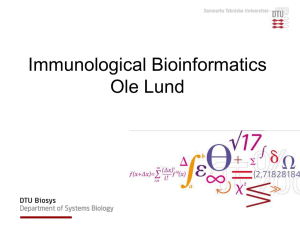
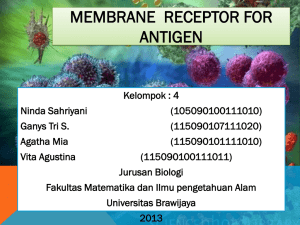
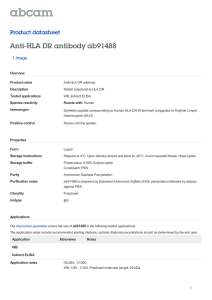
![Anti-HLA-DQA1 antibody [HI118] (PerCP) ab91329 Product datasheet Overview Product name](http://s2.studylib.net/store/data/012448198_1-1438860d79d2655f551f9001711a64ba-300x300.png)
